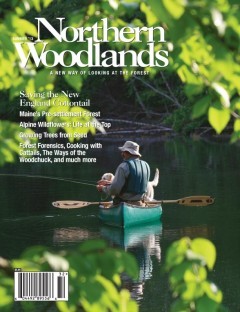This tree seems to have had a branch or a second tree growing from it, then it died, but then it seemed to have grafted itself back. Would appreciate learning more about this.
Jackie Lyman, NH
When two tree branches or stems grow in close proximity to each other, it is possible that they’ll eventually grow large enough to touch. If the bark becomes abraded, say through rubbing caused by swaying in the breeze, it is possible for them to become physiologically – or functionally – connected. This is the basis for grafting.
People have been grafting plants for thousands of years, most commonly to propagate desirable traits such as flower color, fruiting, size, or shape by intentionally joining together two different plants. But both shoot and root grafting occur naturally in trees, without human assistance. In fact, some scholars have suggested that horticultural grafting practices first emerged as early humans attempted to mimic the natural grafting they observed in the wild.
The result of grafting, either natural or horticultural, is a genetically composite organism functioning as one plant. That is, grafting results in the creation of a compound genetic system by uniting two or more distinct genotypes, each of which maintains its own genetic identity throughout the life of the grafted plant. This is why, for example, a branch of a red-flowering rose grafted onto a white rose stock will continue to produce red roses rather than white or pink hybrid roses.
Here’s how grafting works. Just under the bark of all woody plants is a layer of living cells called the cambium. These cells divide and multiply to create bark tissues to the outside of the cambium, and wood tissues to the inside. This is how tree roots, stems, and branches grow larger in girth. And it is the most recently created of these cells on each side of the cambium that perform the vital functions of transporting water and minerals gathered by the roots from the soil up into the tree, and the carbohydrates made in the leaves down into the rest of the tree. Think of the cambium layer as the tree’s plumbing.
When the plumbing system of one tree successfully fuses with that of another, a graft union is formed. But this can only happen under specific conditions. First, the tree parts have to be biologically compatible. That’s why such fusions are more common among the branches, stems, or roots of one tree or between two individual trees of the same species. But it can happen between two trees of closely related species. The more different the species are taxonomically, the less likely a graft can occur between their parts. Indeed, no such grafts have ever been documented between tree species in differing families.
Other requirements for this amazing bit of tree magic are that the tree parts be in direct, prolonged contact; be under pressure; have sufficient moisture and protection from the elements, insects, and pathogens; and have those cambial cells properly aligned. Okay, it’s biology and not actually magic – but it might as well be considering how many things have to go right for it to work. Among northeastern tree species, natural shoot grafting is known to occur in sugar maple, black cherry, red and white oak, sycamore, willows, beech, eastern hemlock, and white pine (as pictured).
It should be noted that there are many occurrences of branches or stems growing very closely together, even touching in what would appear to be a graft union, but that turn out to be separated by layers of bark. These are not true graft unions, because they lack physiological connectivity. The one in question here would appear to be a true graft because the lower portion of the one stem appears dead, while its upper part appears to be alive and well, suggesting a physiological reconnection has occurred. Ah, the near-magic of tree biology.



Discussion *